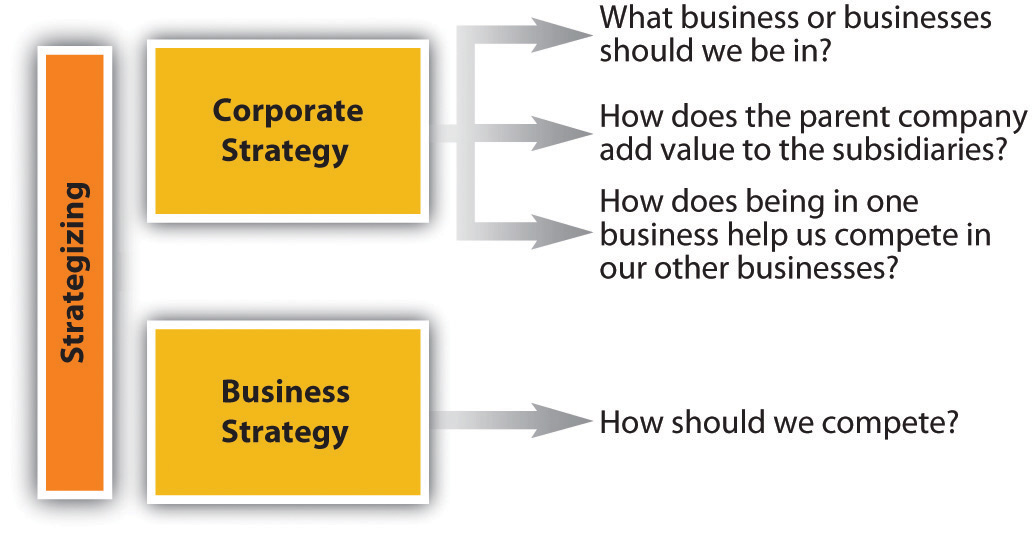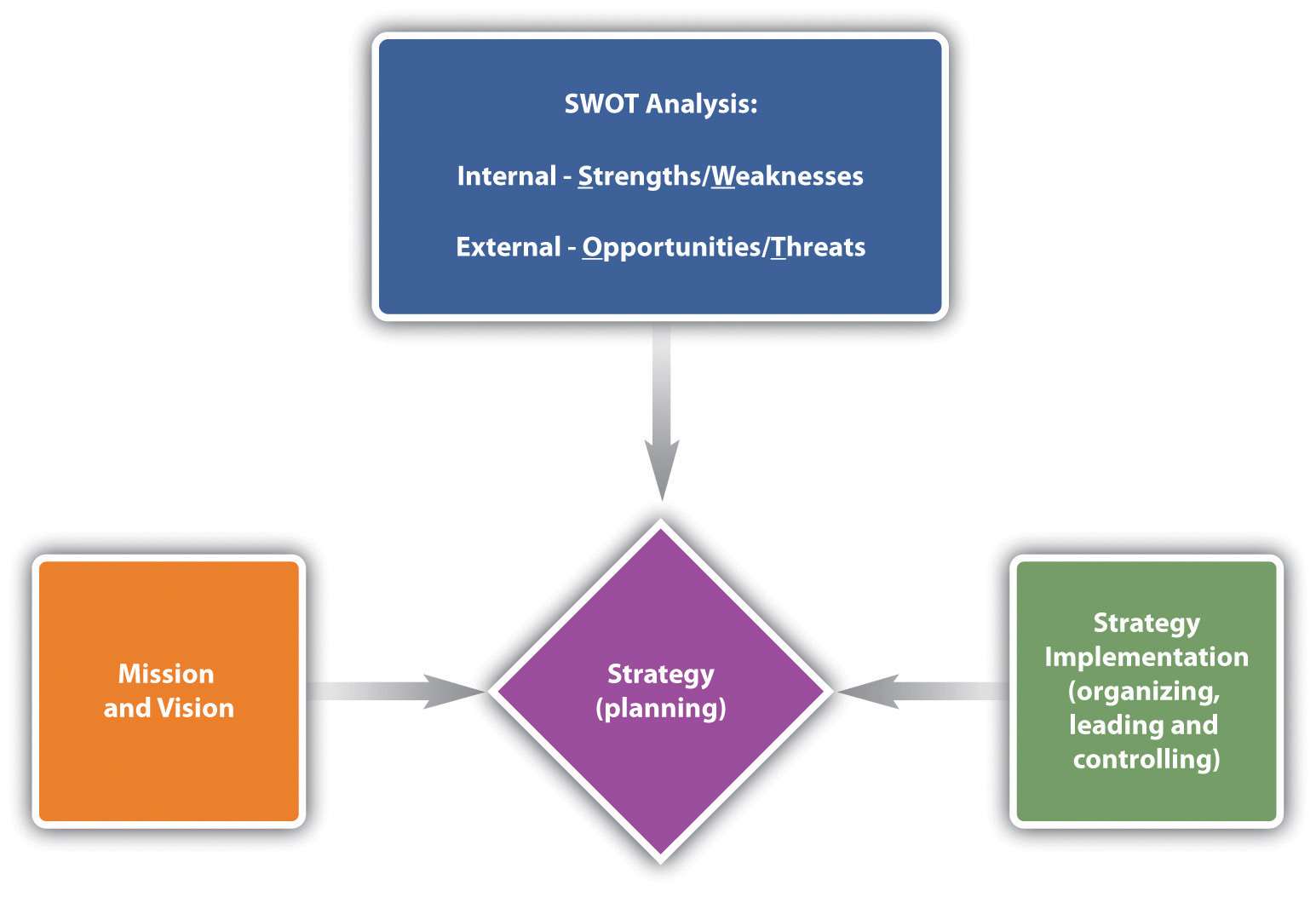10.1 Business and Corporate Strategy
Learning Objectives
- Understand the difference between strategy formulation and strategy implementation.
- Comprehend the relationships among business, corporate, and international strategy.
- Know the inputs into a SWOT analysis.
What Is Strategy?
A strategy is the central, integrated, externally oriented concept of how a firm will achieve its objectives. Strategy formulation (or simply strategizing) is the process of deciding what to do; strategy implementation is the process of performing all the activities necessary to do what has been planned. Neither can succeed without the other; the two processes are interdependent from the standpoint that implementation should provide information that is used to periodically modify the strategy. However, it’s important to distinguish between the two because, typically, different people are involved in each process. In general, the leaders of the organization formulate strategy, while everyone is responsible for strategy implementation.
Figure 10.1 “Corporate and Business Strategy” summarizes the distinction between business and corporate strategy. The general distinction is that business strategy addresses how we should compete, while corporate strategy is concerned with in which businesses we should compete. Specifically, business strategy refers to the ways in which a firm plans to achieve its objectives within a particular business. In other words, one of Splash Corporation’s business strategies would address its objectives within the nutraceuticals business. This strategy may focus on such things as how it competes against multinationals, including Unilever and Procter & Gamble. Similarly, Walmart managers are engaged in business strategy when they decide how to compete with Sears for consumer dollars.
Corporate strategy addresses issues related to three fundamental questions:
- In what businesses will we compete? The Hortalezas, for instance, say that they are in the wellness business; but from the opening case, you can see that they’re talking about specific niche markets related to wellness.
- How can we, as a corporate parent, add value to our various lines of business (often called subsidiaries)? For example, Splash’s senior management might be able to orchestrate synergies and learning by using new products coming out of the Splash Research Institute. It can also glean market intelligence through health and beauty care retail outlets. Market intelligence can give Splash information on which brands are selling well, and some of those brands might be good targets for Splash to acquire, such as it did with the Hygienix brand line. Hygienix is a brand line of antibacterial skin-care products. Corporate strategy deals with finding ways to create value by having two or more owned businesses cooperate and share resources.
- How can diversifying our business or entering a new industry, help us compete in our other industries? The Hortalezas’ experience with the HBC retailers can provide valuable insights into which new products to develop through the Splash Research Institute; in addition, Splash can sell more of its own products through HBC outlets.
International strategy is specialized in the sense that corporate strategy guides the choice of which markets, including different countries, a firm competes in. The different types of international strategy are reviewed in Section 10.3 “International Strategy”. Even when a firm doesn’t sell products or services outside its home country, its international strategy can include importing, international outsourcing, or offshoring. Importing involves the sale of products or services in one country that are sourced in another country. Penzeys Spices, for instance, sells herbs and spices that it buys from all over the world, yet it has retail outlets in only twenty-three states. However, such activity is not limited to small companies like Penzeys. Kohl’s Corporation, one of the largest discount retailers in the country, has stores exclusively in the United States but most of its products are sourced overseas. In outsourcing, the company delegates an entire process (e.g., accounts payable) to the outsource vendor. The vendor takes control of the operation and runs the operation as it sees fit. The company pays the outsource vendor for the end result; how the vendor achieves those end results is up to the vendor. The outsourcer may do the work within the same country or may take it to another country (also known as offshoring). In offshoring, the company takes a function out of its home country and places the function in another country, generally at a lower cost. International outsourcing refers to work that is contracted to a nondomestic third party.
The Strategizing Process
From where does strategy originate? Strategy formulation typically comes from the top managers or owners of an organization, while the responsibility for strategy implementation resides with all organizational members. This entire set of activities is called the strategizing process, as summarized in Figure 10.2.
As you can see with the opening case on Splash Corporation, the strategizing process starts with an organization’s mission and vision. A mission statement is the organization’s statement of purpose and describes who the company is and what it does. Customers, employees, and investors are the stakeholders most often emphasized, but others like government or communities (i.e., in the form of social or environmental impact) can also be impacted (Carpenter, Bauer, & Erdogan, 2011). Mission statements are often longer than vision statements. Sometimes mission statements include a summation of the firm’s values. Organizational values are those shared principles, standards, and goals.
A vision statement, in contrast, is a future-oriented declaration of the organization’s purpose. In many ways, the mission statement lays out the organization’s “purpose for being,” and the vision statement then says, “on the basis of that purpose, this is what we want to become.” The strategy should flow directly from the vision, since the strategy is intended to achieve the vision and satisfy the organization’s mission. Along with some form of internal and organizational analysis using SWOT (or the firm’s strengths, weaknesses, opportunities, and threats), a strategy is formulated into a strategic plan. This plan should allow for the achievement of the mission and vision. Taking SWOT analysis into consideration, the firm’s management then determines how the strategy will be implemented in regard to organization, leadership, and controls. Strategic planning, together with organizing, leading, and controlling, is sometimes referred to by the acronym P-O-L-C. This is the framework managers use to understand and communicate the relationship between strategy formulation and strategy implementation.
Did You Know?
The Fundamentals of SWOT Analysis
SWOT analysis was developed by Ken Andrews in the early 1970s (Andrews, 1971). It is the assessment of a company’s strengths and weaknesses—the S and W—which occur as part of organizational analysis; this organizational analysis of S and W is an audit of a company’s internal workings. Conversely, examining the opportunities and threats is a part of environmental analysis—the company must look outside the organization to determine the opportunities and threats, over which it has less control. When conducting a SWOT analysis, a firm asks four basic questions about itself and its environment:
- What can we do?
- What do we want to do?
- What might we do?
- What do others expect us to do?
Strengths and Weaknesses
A good starting point for strategizing is an assessment of what an organization does well and what it does less well (Carpenter, Bauer, & Erdogan, 2009). The general idea is that good strategies take advantage of strengths and minimize the disadvantages posed by any weaknesses. Michael Jordan, for instance, is an excellent all-around athlete; he excels in baseball and golf, but his athletic skills show best in basketball. As with Jordan’s athleticism, when you can identify certain strengths that set an organization apart from actual and potential competitors, that strength is considered a source of competitive advantage. The hardest but most important thing for an organization to do is to develop its competitive advantage into a sustainable competitive advantage—that is, using the organization’s strengths in way a that can’t be easily duplicated by other firms or made less valuable by changes in the external environment.
Opportunities and Threats
After considering what you just learned about competitive advantage and sustainable competitive advantage, it’s easy to see why the external environment is a critical input into strategy. Opportunities assess the external attractive factors that represent the reason for a business to exist and prosper. What opportunities exist in the market or the environment from which the organization can benefit? Threats include factors beyond your control that could place the strategy or even the business itself at risk. Threats are also external—managers typically have no control over them, but it can be beneficial to have contingency plans in place to address them.
In summary, SWOT analysis helps you identify strategic alternatives that address the following questions:
- Strengths and opportunities (SO). How can you use your strengths to take advantage of the opportunities?
- Strengths and threats (ST). How can you take advantage of your strengths to avoid real and potential threats?
- Weaknesses and opportunities (WO). How can you use your opportunities to overcome the weaknesses you are experiencing?
- Weaknesses and threats (WT). How can you minimize your weaknesses and avoid threats? (Weihrich, 1982)
Key Takeaways
- Strategy formulation is coming up with the plan, and strategy implementation is making the plan happen.
- There are different forms of strategy. Business strategy refers to how a firm competes, while corporate strategy answers questions concerning the businesses with which the organization should compete. International strategy is a key feature of many corporate strategies. In some cases, international strategy takes the form of outsourcing or offshoring.
- An overview of the strategizing process involves a SWOT (strengths, weaknesses, opportunities, threats) analysis and the development of the organization’s mission and vision.
Exercises
(AACSB: Reflective Thinking, Analytical Skills)
- What is the difference between strategy formulation and strategy implementation?
- What are the different levels of strategy?
- To what level of strategy do outsourcing, offshoring, and international strategy belong?
References
Andrews, K. R., The Concept of Corporate Strategy (Homewood, IL: Richard D. Irwin, 1971).
Cappelli, P., Harbir Singh, Jitendra Singh, and Michael Useem, “The India Way: Lessons for the U.S.,” Academy of Management Perspectives 24, no. 2 (2010): 6–24.
Carpenter, M., Talya Bauer, and Berrin Erdogan, Principles of Management, accessed January 5, 2011.
Weihrich, H., “The TOWS Matrix—A Tool for Situational Analysis,” Long Range Planning 15, no. 2 (April 1982): 52–64.



